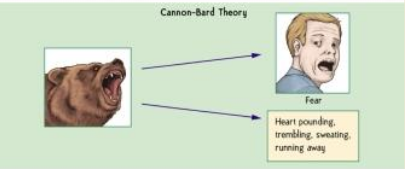Unit 4 - Emotion
1/15
There's no tags or description
Looks like no tags are added yet.
Name | Mastery | Learn | Test | Matching | Spaced |
|---|
No study sessions yet.
16 Terms
Emotion
Complex reaction pattern involving thoughts, feelings, and actions
James-Lange Theory
An emotion provoking stimulus a physical response, that then leads to emotion. Emotion follows behavior
“We feel sorry because we cry; angry because we strike; afraid because we tremble.”-William James

Cannon-Bard Theory
A theory that an emotional feeling and an internal physiological response occur at the same time
Emotion and behavior simultaneously

Schachter Two-Factor Theory
This theory suggests that the emotions we feel depend on two things
our internal physical state
the external situation we find ourselves in.

Facial Feedback Hypothesis
Facial movement and expressions can influence attitude and emotional experience
Broaden-and-Build Theory
a model in positive psychology that suggests that positive emotions can help people build useful skills and psychological resources over time
Universal Emotions theory
a concept in psychology that suggests there are six basic emotions (happiness, sadness, anger, fear, surprise, and disgust) that are universally expressed and recognized across different cultures
Seven Basic Emotions
Paul Ekman (CH SAF SD)
contempt
happiness
sadness
anger
fear
surprise
disgust
Display Rule
A social group or culture's informal norms about how to appropriately express emotions
Individualist cultures
often express their emotions more, in speech & body.
However, all cultures exhibit the worldwide smiles, frowns, & angry faces of humanity
Affect
The broad experience of feeling or emotion, including moods and immediate emotional responses
Internal and External Factors
Internal: Biological and psychological influences (e.g., personality, past experiences).
External: Environmental and social stimuli affecting emotions.
Physiological vs. Cognitive Experiences
Physiological: Bodily reactions (e.g., heart rate, sweating).
Cognitive: Mental processes (e.g., interpretation, awareness)
Cognitive Label
The interpretation assigned to physiological arousal, shaping the experienced emotion
Cognitive Appraisal
The evaluation of a situation that determines emotional response
Elicitors
Triggers of emotional responses, either internal (thoughts) or external (events)